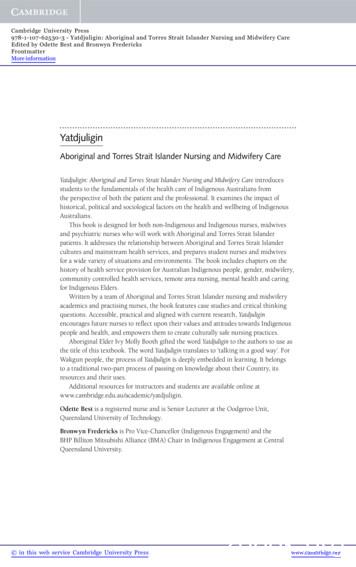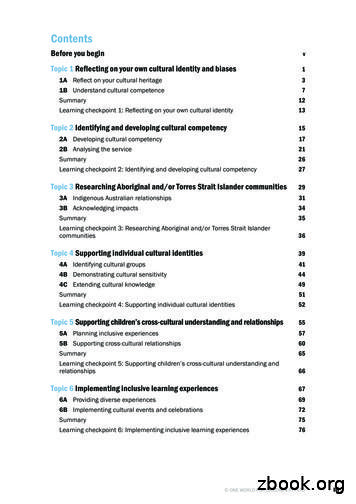Cultural Connections - PolarTREC
Cultural ConnectionsOverviewHumans hold special relationships with the natural resourcesby which they are surrounded. These connections areincreasingly being challenged by changing climate patterns,availability of resources, and societal changes. In this activitystudents will investigate the cultural importance of an Arcticplant or animal. Each student will create a carving andresearch traditional uses, geographic range, and naturalhistory of an Arctic plant or animal. This lesson was inspiredby Sandra L. W. Thornton’s experiences as a PolarTRECFellow/NOAA Teacher at Sea during the Hidden Ocean 2016:Chukchi Borderlands expedition and especially after viewingthe beautifully constructed and detailed artifacts at theAnchorage Museum and the Alaska Native Heritage Center,both located in Anchorage, Alaska.ObjectivesStudents will be able to describe geographic range, naturalhistory, and cultural importance of an Arctic plant or animal.Lesson PreparationThis lesson may be used to introduce or assess a unit onecology, adaptations, or the Arctic. Because students willuse their own research when constructing their models, nospecialized prior knowledge is needed to begin this lesson.Examples of Arctic carvings may be found at the AnchorageMuseum website ticLess than a weekDownload, Share, andRemix All AgesMaterialsCarving tools (plastic or woodare recommended; plasticknives and spoons may serveas inexpensive alternatives)Bar soap (Ivory isrecommended because it isvery soft and easily carved.)Cardstock or paper for tabletentsMarkers, colored pencils, andother art suppliesInternet access or othermaterials to facilitate theresearch component of theassignment
Instructor should emphasize that students will be assessedon the quality of their research rather than their artisticability.StandardsProcedureNext Generation ScienceStandards (NGSS)InitialThis lesson supports the NextGeneration Science Standardsby challenging students toresearch Arctic organisms,construct models, andcommunicate the results oftheir research.1. Students will choose a plant or animal found in theArctic. Students should be encouraged to choose fromplants, birds, marine animals, and land-based animals.Depending upon placement within an instructional unit,students may need to conduct initial research tobecome more familiar with Arctic plants and animals.Production1. Students will conduct research to determine:a. Scientific name, traditional uses, cultural significance,geographic range, and natural history of the plant oranimal.b. Students will prepare a table tent display cardshowing the information for their plant or animal.2. Students will create a soap carving of their plant oranimal. See “Student Handout” for instructions on howto create a soap carving.ExtensionAs an alternative to soap carving, students mayconstruct models using clay, fabric, papier mache’,water colors or other media depending upon studentskills and availability of resources.Students may choose to research and compare anArctic plant or animal to a plant or animal that issignificant in their home community or culture.It is recommended that carvings and display cards beplaced in a central area where others may view studentwork. Libraries, banks, museums, community centers,Elementary School2-LS4-1 Biological Evolution:Unity and Diversity. Makeobservations of plants andanimals to compare thediversity of life in differenthabitats.3-LS4-3 Biological Evolution:Unity and Diversity. Constructan argument with evidence thatin a particular habitat someorganisms can survive well,some survive less well, andsome cannot survive at all.4-LS1-1 From Molecules toOrganisms: Structures andProcesses. Construct anargument that plants andanimals have internal andexternal structures that functionto support survival, growth,behavior, and reproduction.Middle School
and local businesses are often willing to display ssessmentStudents will be assessed on the quality of their researchproduct. This lesson provides opportunities for students tolocate resources and determine the factual merit of theseresources. Because the aesthetics of artistic products issubjective, it is recommended that assessment be based onquality and scope of student research. A suggested rubrichas been provided with the “Student Handout”.MS-LS2-1 Ecosystems:Interactions, Energy, andDynamics. Analyze andinterpret data to provideevidence for the effects ofresource availability onorganisms and populations oforganisms in an ecosystem.High SchoolHS-LS4-5 Biological Evolution:Unity and Diversity. Evaluatethe evidence supporting claimsthat changes in environmentalconditions may result in (1)increases in the number ofindividuals of some species, (2)the emergence of new speciesover time, and (3) the extinctionof other species.Author / CreditsThis lesson was created by Sandra L. W. Thornton (slwthornton@gmail.com).
Cultural Connections Student HandoutCultural ConnectionsOverview: Humans hold special relationships with the natural resources by which they aresurrounded. These connections are increasingly being challenged by changing climate patterns,availability of resources, and societal changes. In this activity you will investigate the naturalhistory and cultural importance of an Arctic plant or animal, and use what you have learned tocreate a soap carving of the Arctic or Antarctic animal and a display card identifying theorganism, scientific name, traditional uses, geographic range, and natural history.Options:As an alternative to soap carving, you may construct a model using clay, fabric, papiermache’ or other media.Materials and Equipment: Carving tools (plastic or wood are recommended; plastic knives and spoons mayserve as inexpensive alternatives)Bar soap (Ivory is recommended because it is very soft and easily carved.)CardstockMarkers, colored pencils, and other art suppliesInternet access or other materials to facilitate the research component of theassignment.Procedure:1. Follow the procedure on the “carving” handout to create your model.2. Prepare a table tent that includes:a. Organism, scientific name, traditional uses, geographic range, and naturalhistory.b. This table tent will be displayed with your carving and should reflect exhibitionlevel work. You will be evaluated on the following criteria:i. Table tent includes all required information.ii. Table tent is neat, legible, and attractive.iii. Table tent is suitable for display.
Cultural Connections Student HandoutScoring RubricCategoryIncluded & ProperlyFormatted3Included; ImproperlyFormatted2Standard Met3Standard Not Met;Standard Met; Minor Requires SignificantRevisions NeededRevisions20Not Included0OrganismScientific NameTraditional UsesGeographic RangeNatural HistoryLife SpanFood SupplyRole in EcosystemSpecialAdaptationsFecundityCurrent ThreatsTable TentRequiredInformationNeat, Legible,AttractiveSuitable for DisplayTotal Score
Cultural Connections Student HandoutSoap Carving1. Preparing the Materialsa. Gather carving equipment. Carvingtools or metal or plastic cutlerywork well. Small wooden skewersand sharpened pencils work wellfor adding details to the carving.b. Sketch an outline of the plant oranimal that will be carved. Theoutline should fit on the bar ofsoap.c. Place the outline on the soap anduse a pencil to trace over theoutline. A small amount of pressurewill allow the outline to beimpressed into the soap surface.2. Carve around the outline and then adddetails. Begin with larger details andthen work to finer details. Be sure toshave off any logo that may be on thesoap.3. Use a soft cloth to gently polish thecarving.
Soap Carving 1.Preparing the Materials a.Gather carving equipment. Carving tools or metal or plastic cutlery work well. Small wooden skewers and sharpened pencils work well for adding details to the carving. b.Sketch an outline of the plant or animal that will be carved. The outline should fit on the bar of soap. c.Place the outline on the soap and
provider (ISP) connections (including branch connections) No connections Minimal complexity (1–20 connections) Moderate complexity (21–100 connections) Significant complexity (101–200 connections) Substantial complexity ( 200 connections) Unsecured external connections, number of connections not users (e.g., file transfer protocol (FTP),
4. Cultural Diversity 5. Cultural Diversity Training 6. Cultural Diversity Training Manual 7. Diversity 8. Diversity Training 9. Diversity Training Manual 10. Cultural Sensitivity 11. Cultural Sensitivity Training 12. Cultural Sensitivity Training Manual 13. Cultural Efficacy 14. Cultural Efficacy Training 15. Cultural Efficacy Training Manual 16.
Figure 5: DVD, Blu-ray Player and Cable, Satellite, HDTV tuner Connections 10 Figure 6: DVD-A or SACD Player Connections 10 Figure 7: Video Recorder Connections 11 Figure 8: CD Player Connections 11 Figure 9: Audio Recorder Connections 12 Figure 10: AM/FM / Internet Radio Tuner Connections 12 Figure 11: USB Audio /iPod Connections 13
for three connections intended to be used for accelerated bridge construction. These connections include rebar hinge pocket connections, hybrid grouted duct connections, and SDCL steel girder connections. The document also presents a short background information and a concise summary of the main research study conducted toward
Moment resisting connections are used in multi-storey un-braced buildings and in single-storey portal frame buildings. Connections in multi-storey frames are most likely to be bolted, full depth end plate connections or extended end plate connections. The most commonly used moment resisting connections are bolted end plate beam-to-column .
3 The cultural safety journey: An Australian nursing context 51 Odette Best Introduction 52 Developing the theory of cultural safety 52 The Australian context: Developing cultural awareness 54 Moving beyond cultural awareness to cultural sensitivity 62 The continuous journey towards cultural safety 63
Topic 1 Reflecting on your own cultural identity and biases . 1 1A Reflect on your cultural heritage 3. 1B Understand cultural competence 7 Summary 12. Learning checkpoint 1: Reflecting on your own cultural identity 13. Topic 2 Identifying and developing cultural competency . 15 2A Devel
criminal justice systems in terms of homicide cases solved by the police, persons arrested for and per-sons convicted of homicide. Bringing the perpetrators of homicide to justice and preventing impunity for those responsible for lethal violence is a core responsibility of the State. Indeed, there is international recognition1 that the State is required to provide judicial protection with .























